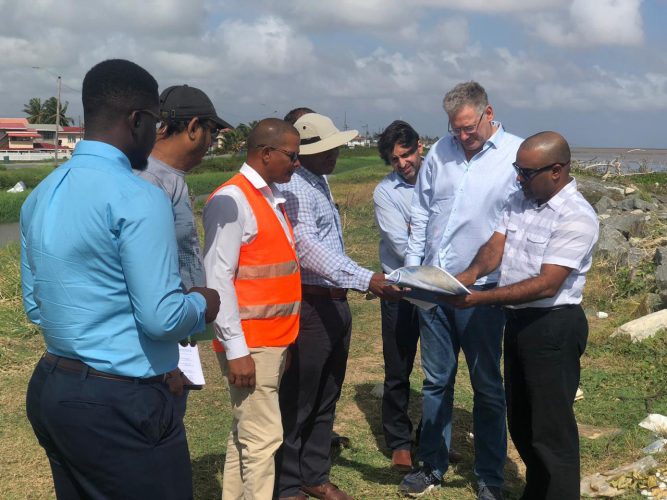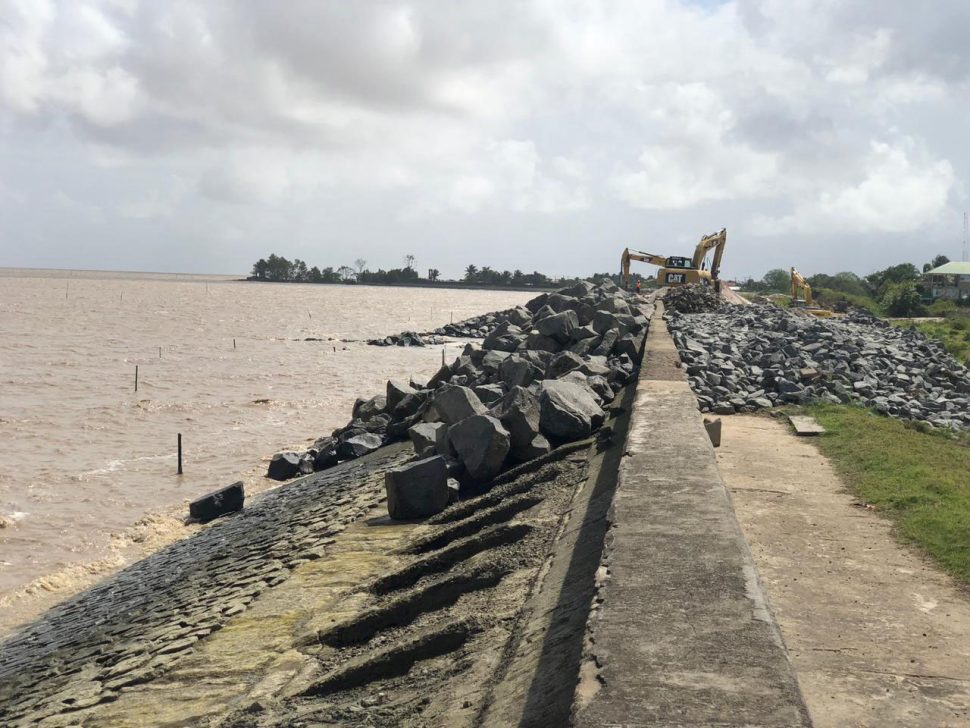Over its four decades-long presence in Guyana, the European Union (EU) has provided over $20.1 billion (€85 million) in grant funding for the construction and rehabilitation of the country’s sea defence structures.
This was revealed last Thursday as a team from the Delegation of the EU in Guyana comprising Head of the Delegation Jernej Videtič, Project Manager Federico Suarez, and Head of Co-operation Karel Lizerot, along with Ministry of Public Infrastructure representatives including Chief Sea and River Defence Officer Kevin Samad, visited three sites – Ruimzigt/Waller’s Delight, La Jalousie and Leonora – where there are ongoing sea defence works. The EU has been here since the late 1970s.
At the three West Coast Demerara sites, the EU reps were briefed on the progress of works as well as the technical aspects including the efficiency of using the new rock arm/rip rap structures that are designed to be more cost-effective while adding more protection by reducing more of the incoming waves’ energy.
After the visit to the sites, Stabroek News sat down with Lizerot and Suarez who revealed that over the years, the EU has provided over $20.1 billion in grant funding for sea defence works here.
Currently, the EU is in its 11th European Development Fund (EDF) cycle. The cycles are divided into seven- year periods. The 11th EDF started in 2013 with approximately $8 billion provided for sea defence works locally.
However, unlike the previous cycles where the projects would be coordinated by the EU itself, over the last 12 years, the monies have been given directly to the country’s Treasury and the Ministry of Finance (MoF) through budgetary support.

“We are the only donors that have a national programme with Guyana and…grants…means we give the money, we don’t lend it unlike others such as the IDB [Inter-American Development Bank], CDB [Caribbean Development Bank]… they are giving loans and it’s probably good rates but these are still loans. We have moved under the 10th EDF for budget support,” Lizerot said. He noted that usually they put the projects together, control them and contract, because Guyana cannot manage the money.
However, for the last 12 years, since the 10th EDF cycle, they have changed their approach from a project-based one to budgetary support, which he said, points to the management of Guyana’s budget being “good enough.”
“Because there is the Minister of Finance [Winston Jordan] and the Treasury, we are giving the money directly to them and so when they present the national budget, it’s part of it and then the state is contracting these guys we are seeing on the seawall themselves so it actually becomes Guyanese money and so that’s the trick about the budget support because if it was projects, we would’ve contracted these guys and managed them,” he explained, while highlighting that before the EU decided to change from project-based support to budgetary support, they would’ve assessed the criteria to know if the country could move in that direction, as well as worked along with reforming the sector.
“Because in budget support, you have different methodology and Guyana has successfully passed the check to be a country that can receive budget support. If the indicators are met, we pay,” he added.
Shores
Suarez also pointed out that the construction of new infrastructure on the shores of the country as well as the rehabilitation and repair of the old ones are not the major project but only one aspect in the grand scheme of promoting climate change adaptation through sustainable Integrated Coastal Zone Management (ICZM).
The main activities of the programme include an ICZM legal framework; the implementation of a Disaster Risk Management and Resilience Policy at regional and community levels; preventative maintenance and risk management of the sea defence; urban storm water drainage management and the consolidation of mangrove defences and monitoring of protected areas.
The programme also targets gender equality as a cross-cutting issue and they are hoping that it will result in increased participation by women in the decision-making processes on climate and environmental issues through enlarged representation on the Sea and River Defence Board. Additionally it also aims to promote girls and women in science, technology and engineering.
According to data provided by Suarez, during the 2017 and 2018 period, women’s representation on the Sea and River Defence Board increased to at least 33 per cent, while Industrial Attachment internships were provided.
In terms of sea defence infrastructure, approximately 7.2 km was rehabilitated and 35 km was maintained while four new mangroves sites were established.
A comprehensive awareness campaign for girls and women to study science, engineering and technology was also implemented while regional multi-hazard preparedness and response plans have been completed for different regions. Work on a Disaster Risk Management Bill has started and will be finished and sent to the National Assembly before June 30 this year.
For this year, 3.1 km of sea defence will be constructed. There will also be rehabilitation of 3.08 km and the maintenance of 23.5 km, which accounts for works at more than 30 different sites around the country. Also in train is an increase in drainage pumping capacity in coastal locations and Georgetown which will see the installation of a new four cubic meters per second drainage pump and the upgrading of 1000 metres of outfall channels.
Two mangrove sites and two protected areas will also be established under the Guyana Forestry Act.
When questioned about whether the EU is satisfied with the quality of work and its rate of completion, Suarez said yes and pointed out that they do checks before paying.
“If we are paying, it means we are satisfied. Of course you always have room for improvement,” he said.
In terms of a holistic assessment of the total work needed for the country’s entire sea defence to be adequate and the cost, Lizerot said that it would be difficult to say since there has not been any such study done.
“I am not sure if there have been studies done in the past to gauge what needs to be done other than what the EU and the CDB are doing. Where we are now and what we need to do is a completely different issue. Without the EU, there would probably be nothing remaining. We know that climate change is affecting different countries so we need to adjust. If we are going to do another sea defence support we know we have to check the last improvement with climate change and adapt. We need to know that in this current budget support we are doing an investment… we are not only thinking in the present but the future and also increasing the capacity of pumping and drainage because we know we will need more,” he explained.
Citing his personal view, Lizerot also said that moving the capital city further inland would be a bad idea. He said priority should be placed on keeping the country’s defence from the ocean in shape while ensuring that there are better drainage systems in Georgetown.
“We can encourage preventative maintenance. It’s like the very essence of your country is that you are just in a situation where you are under the sea level. It’s one of the highest priorities for survival itself and the functioning of the country. Of course, there are other things that should be done with all the social systems and provisions of basic services that are highly important. But in terms of managing your geographical situation, it will forever remain like that,” he said, when questioned on whether sea defence should be one of the top priorities for expected oil revenue.
In terms of the mangroves afforestation programme, he said the project, which was funded by the EU with over $1 billion, has become self-sustainable.









